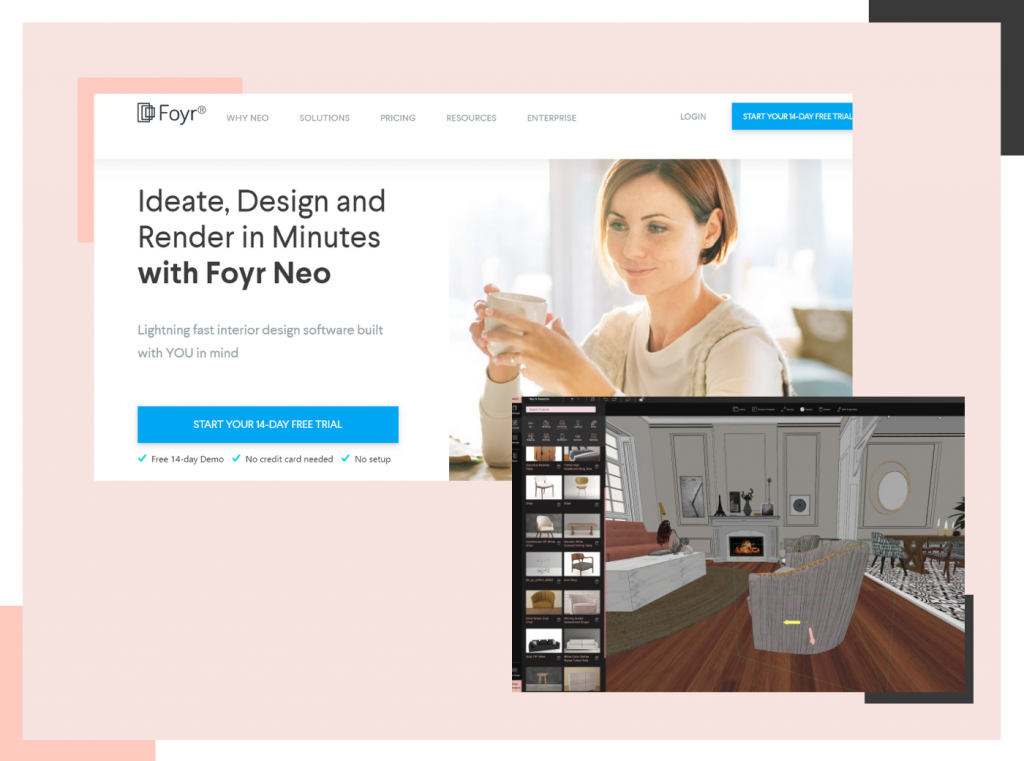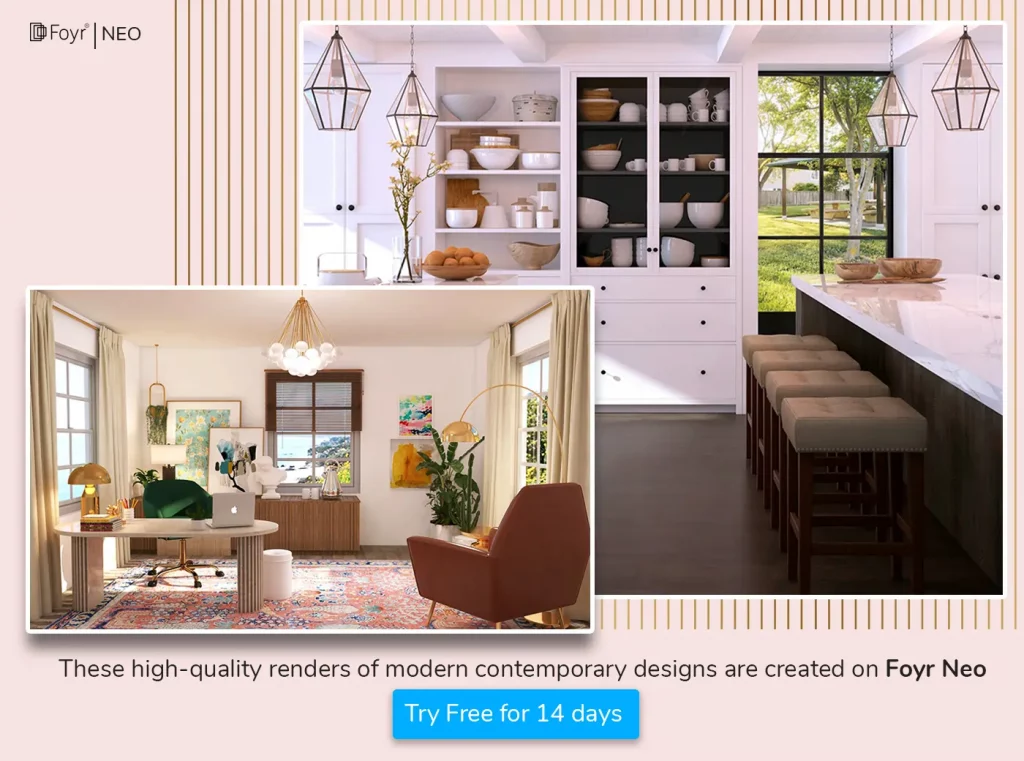Learn » Design Software & Tools »
Do you really need home design software programs when you already have a sharp mind and a blank sheet of paper in front of you? Who needs to invest in software to design when you can create stunning works of art in home decor with just pencil sketches? Well, homeowners, whether they’re looking for a new home design or a remodel or a home renovation want nothing short of surreal designs that are self-explanatory, requiring no technical knowledge, understandable upon first look without the designer having to explain, and clearly see themselves living in the space.
For this to happen and for you to bag blue-chip, big-league homeowners your design quality needs to be top-notch, which begs the use of a photorealistic software, that sits lightly on your pocket, is DIY-friendly and takes a short while to learn and use. For beginner designers like you who want to get a stronghold without investing too much in systems right away, you need a pocket-friendly tool to give you a headstart.
There are so many tools like Foyr Neo, Homestyler, smartdraw, Sweet Home 3D, Sketchup, AutoCAD, etc, which can make your tool shopping difficult. That’s why we’ve put together this exhaustive comparison of 5 well-known DIY interior design software, their pros and cons so you can decide which is best for your use.
Top 5 DIY Interior Design Software:
1. Foyr Neo
[wp-svg-icons icon=”star-3″ wrap=”i”][wp-svg-icons icon=”star-3″ wrap=”i”][wp-svg-icons icon=”star-3″ wrap=”i”][wp-svg-icons icon=”star-3″ wrap=”i”][wp-svg-icons icon=”star-2″ wrap=”i”]
Our core team of interior designers has curated their experiences, anticipated your needs way ahead, and built a future-ready tool that intuitively knows what you want.
- Start simply with a 14-day free trial, and discover infinite possibilities to create a high-quality lifelike design that resonates with the ideal future your client has envisioned.
- You can start this incredible design journey by drawing up or importing your own accurate, high-resolution, precise 3D floor plan that leaves no detail in the dark.
- You can choose from 10,000+ preset design templates from the library, create your own mood board, select and drag and drop from 50,000+ elements, and start designing.
- The 360 camera feature helps you assess your design quality from different angles with a simple click.
- Create 4K quality walkthroughs, and enjoy visualization in premium quality settings.
The cloud-based engine accelerates your design process 5x better than the tools that require special hardware to run or forced restarts to stop glitching. If you want to enjoy these features for a longer time, the basic plan starts from $49/month and goes up to $340/month for the premium plan.
Read also – How to Draw a Floor Plan & Top Mistakes to Avoid
2. Sketchup
[wp-svg-icons icon=”star-3″ wrap=”i”][wp-svg-icons icon=”star-3″ wrap=”i”][wp-svg-icons icon=”star-3″ wrap=”i”][wp-svg-icons icon=”star-3″ wrap=”i”][wp-svg-icons icon=”star” wrap=”i”]
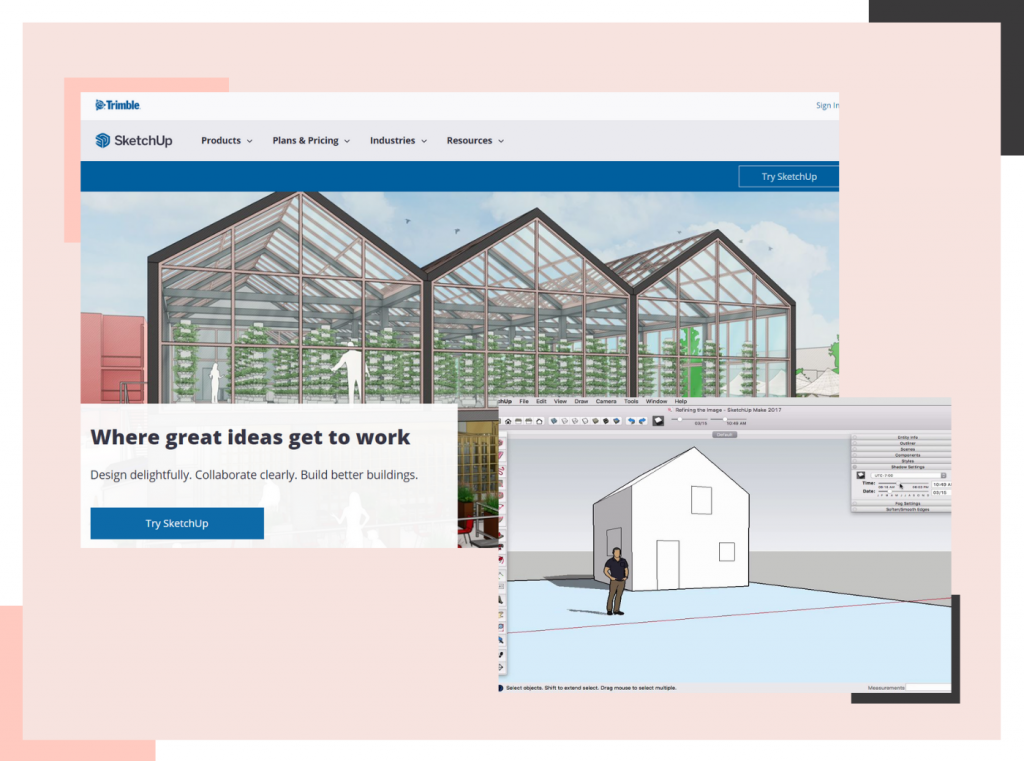
Sketchup is a versatile 3D modeling software that can perform many functions at once and produce picturesque designs every time. It has a user-friendly UI and an intuitive platform for absolute beginners to get familiarized with. It’s pretty easy to get started and has a wide arsenal of tools and a huge library of templates to choose from. If you already run your interior design business with software, you can still integrate Sketchup with any tool of your choice.
The first setback for the tool is its exorbitant pricing. After the free trial, when you need to upgrade, you are left with rather pricey options like Shop ($119/year), the next higher-end option is Sketchup Pro ($299/year) with a lot of other features, and the highest package would be Studio ($1199/year) with everything they offer in the first two packages, plus collaboration with multiple stakeholders and an AR viewer, which is unavailable in the other packages.
- The next con is its severely limited rendering.
- Even at the highest package, the rendering feature takes eons and produces only mediocre-level output, which is startling for a costly tool like Sketchup.
- It also has a steep learning curve.
- Another complaint users put forth is the limited modeling capabilities Sketchup has.
- If you want high-quality rendering, you will have to use different plug-ins.
- Customer service is deemed to be unreliable a lot of times.
Read also – 10 Best SketchUp Alternatives for Designers in 2023
3. AutoCAD
[wp-svg-icons icon=”star-3″ wrap=”i”][wp-svg-icons icon=”star-3″ wrap=”i”][wp-svg-icons icon=”star-3″ wrap=”i”][wp-svg-icons icon=”star-3″ wrap=”i”][wp-svg-icons icon=”star” wrap=”i”]
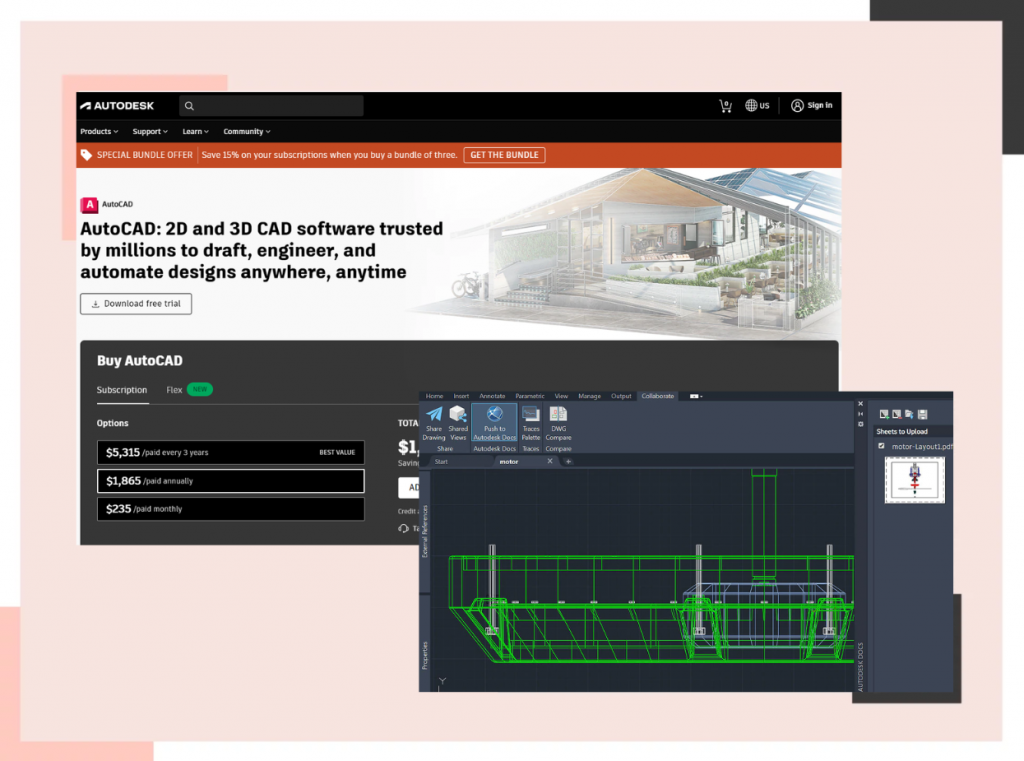
One of the earliest tools to occupy the interior design software market, AutoCAD is a household name among architects and interior designers. It’s an efficient, user-friendly program that’s incredible for creating and editing designs, and to create models, sketches, and drawings. It also helps you visualize and render the designs in 3D seamlessly. The tool allows you to spot and correct errors easily, which can be a lifesaver and prevent wastage of your client’s precious budget.
Another brownie point of AutoCAD is that if you have any 3D models you generated from other tools that need to be modified or enhanced, you can simply import them onto the tool and get on with your work. When compared to other cumbersome tools in the market, AutoCAD has a comparatively simpler UI, and with extensive experience using the tool, it can be understood and used better on a day-to-day basis. The design quality is good, and you can guarantee precise dimensions with a helpful ability to export designs.
If you’re taking on multiple clients and want to sport a supportive tool, AutoCAD also can be used to manage all your home design projects in one place. It’s been patronized by the design community for a long time and is purchased by beginners and experts almost immediately when they enter the interior design business. It costs $50/month, but for that cost, you will also need to take into account the setbacks it has.
- The major drawback for AutoCAD is its need for high-end hard disk and RAM capabilities that cannot be found in everyday use laptops.
- Most designers say they will need to get a desktop or an expensive, high-performance laptop to install and run AutoCAD successfully.
- If you make any errors unknowingly while designing, it can choke the application, or cause it to crash, forcing you to hard restart to access your design and continue with it.
- Although dimensions are precise, it’s difficult for beginners to set them right without getting lost in the maze of options the tool has to offer.
- The steep learning curve is no stranger to AutoCAD. You need years of practice on the tool to get to know it as the back of your hand.
- The rendering is also too expensive, and you will have to spend big bucks over and above the cost of the tool to generate renders to match the quality of your peers.
Read also – How To Become a Certified Interior Designer Without A Degree?
4. Chief Architect’s Home Designer
[wp-svg-icons icon=”star-3″ wrap=”i”][wp-svg-icons icon=”star-3″ wrap=”i”][wp-svg-icons icon=”star-3″ wrap=”i”][wp-svg-icons icon=”star-3″ wrap=”i”][wp-svg-icons icon=”star” wrap=”i”]
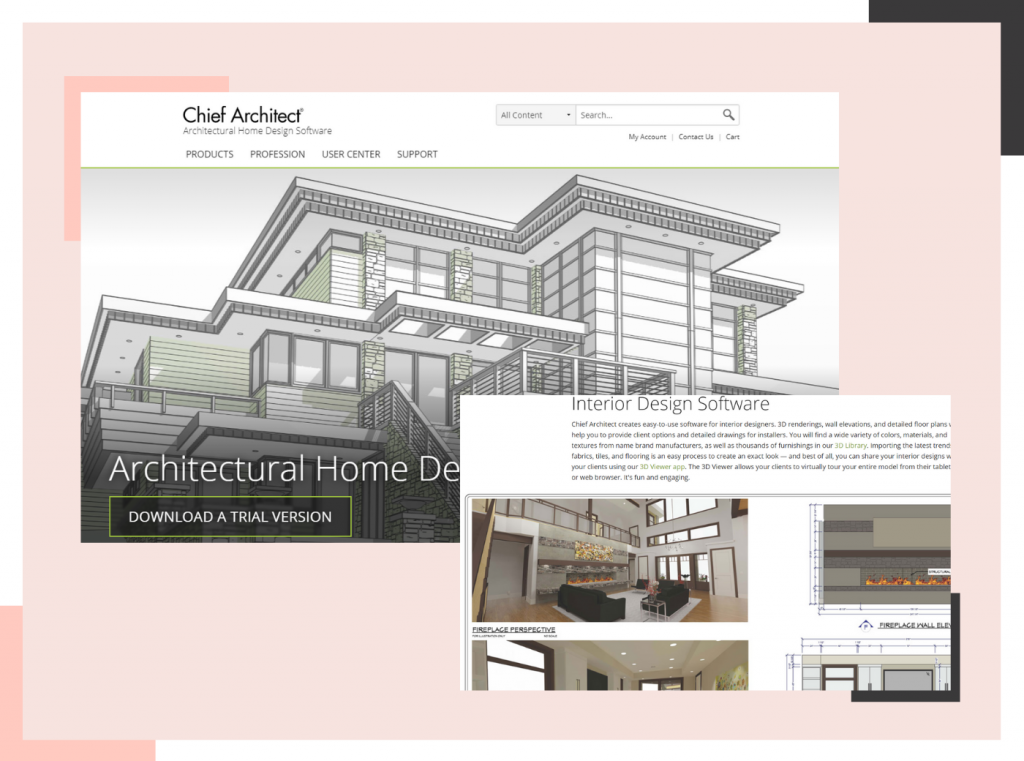
An interior design exclusive tool curated by Chief Architect’s brand is Home Designer, which is a top-rated 3D software you can use for indoor and outdoor living projects. It comes with a free trial and basic plan that offers ease of use and is affordable for small businesses. The 3D view can be fragmented easily, and viewed on a separate screen while comparing it with a 2D plan. You can render floor plans in 3D, and assess the suitability of your designs in no time. You can quickly customize the design, and change camera angles to ascertain how your well-crafted design looks from different eye levels and angles.
The flip side to this tool is that before you acquaint the current version of the tool, it gets updated which makes it difficult to understand the functionality of each feature.
- The materials library, something which is sacrosanct for beginner interior designers like you is very outdated and doesn’t serve your need to design premium, contemporary homes that look elegant and stylish.
- To be able to find simple everyday elements to add to your design you will have to perform extensive searches that hardly bear fruit even after searching for a long while.
- Surprising for an advanced tool like Home Designer, the walls get in the way of viewing your designs from different angles.
- The tool isn’t smart, there are no auto-adjustable options and you will need to expend your time and energy doing everything manually.
- It’s not easy to draw using Home Designer given the complexity of the tool.
- Even the basic features are available at a price, which is unfair to those who want to try out the free trial to gauge the suitability of the tool to their business and client projects.
Read also – How to choose the best blueprint maker?
5. Roomsketcher
[wp-svg-icons icon=”star-3″ wrap=”i”][wp-svg-icons icon=”star-3″ wrap=”i”][wp-svg-icons icon=”star-3″ wrap=”i”][wp-svg-icons icon=”star-2″ wrap=”i”][wp-svg-icons icon=”star” wrap=”i”]
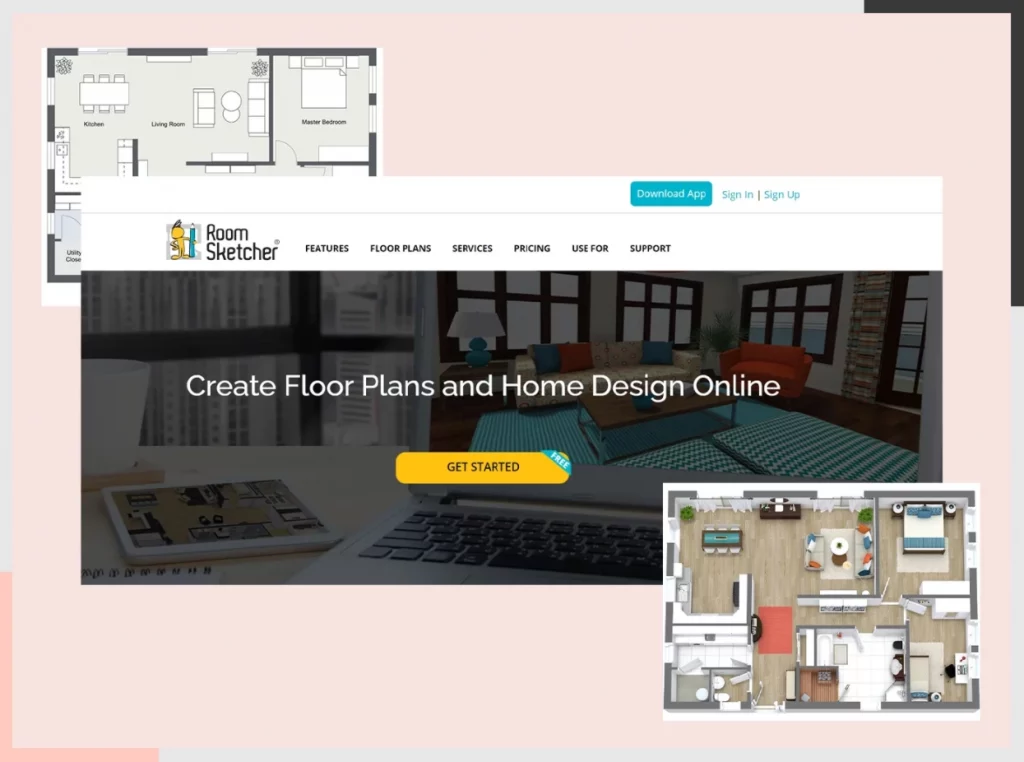
One of the simplest tools to use to design floor plans and homes for simple and premium projects is Roomsketcher. It comes with a free version and also offers the leeway to use the tool on a project-to-project basis. There’s an abundance of flexibility in designs and plenty of options for you to choose from with respect to flooring, tile, furniture, etc.
Creating room structures and 3D walkthroughs of your client’s home is a breeze with Roomsketcher. You can easily see the impact of your changes on the entirety of your design without having to face several glitches along the way. The tool especially offers a virtual tape you can use to measure the distance between furniture, built-in cabinets, walkways, etc, so your design is immaculate.
The design preview serves a good purpose and highlights areas of improvement and design ideas you might to focus on before you begin rendering.
- The tool is rather pricey and has a steep learning curve which drags on your learning process longer than usual.
- The 3D renders do not accommodate differential lighting, which becomes a hassle along the way.
- The holes for sinks in your kitchen design, furniture, and gutter route in your landscape design need to be put manually which tends to disrupt the lighting and wall decor already in place.
- Moreover, if you want to select multiple decoration items at once, you cannot, as it tends to slow down the entire workflow.
The most concerning part is you need to pictures at every step to check the progress of your design, detect errors early on, and correct them.
Read also – 6 AI-powered Interior Design Software Solutions
Wrapping Up
Choosing the right interior design software is paramount if you need to project yourself as an authority, make a good impression, and gain your client’s trust that you will be able to build safe, beautiful, luxurious dream homes for them and their future. To make their lifelong dream come true, you need to spend hours coming up with dazzling designs, try out different combinations, and see what works best. In this super-creative process, you don’t want a home design app interrupting your genius or testing your patience. Get a tool that glides along your journey, giving you everything you need and helping you realize your ideas soon, while also caring about your budget and multiplying your revenue.
Fire up your Mac or laptop, get on Foyr Neo’s 14-day free trial, and see for yourself, you will thank yourself later.
FAQs
Foyr Neo stands out with its advanced 3D rendering, augmented reality capabilities, and extensive library of 3D furniture models and materials, making it a top choice for realistic design visualization.
Foyr Neo and RoomSketcher excel in collaboration and sharing options, with real-time collaboration features and the ability to share projects with clients or team members for feedback.
Foyr Neo is well-regarded for creating professional presentations and mood boards due to its advanced 3D rendering capabilities, which allow for the creation of immersive and realistic visual presentations that can impress clients.
When selecting the right software for your interior design project, consider factors like ease of use, available features, compatibility with your design style, 3D visualization quality, and pricing.







